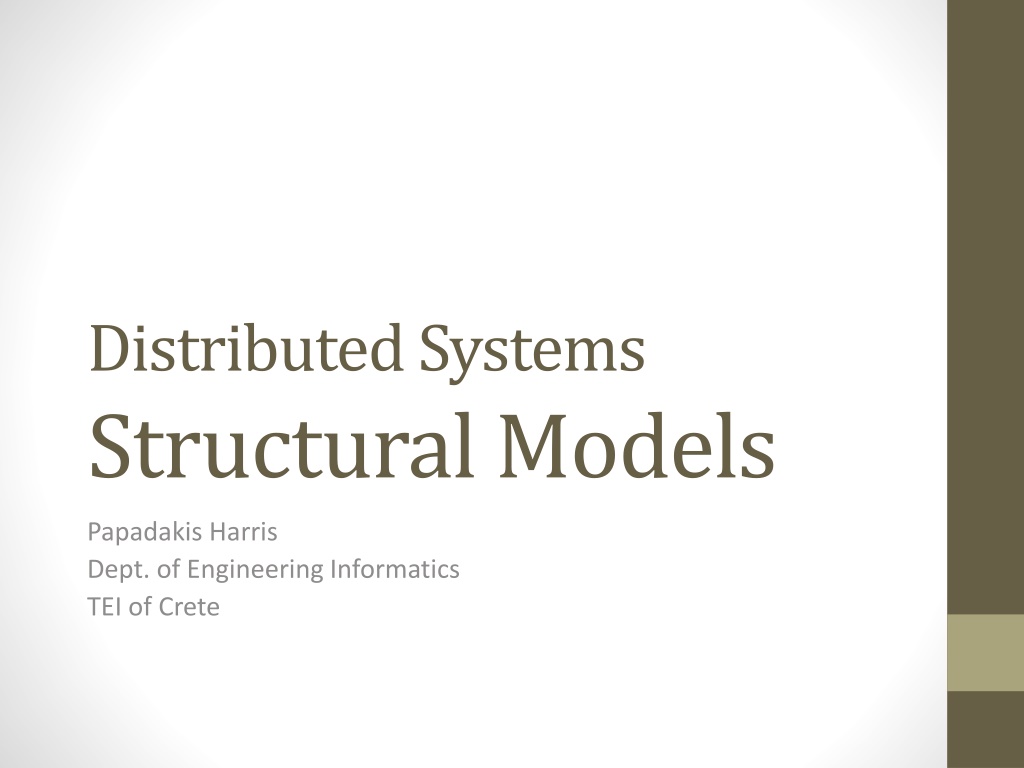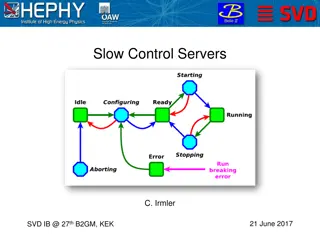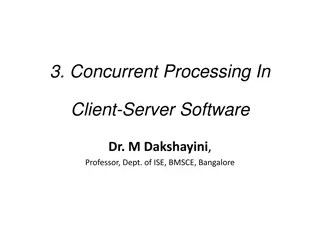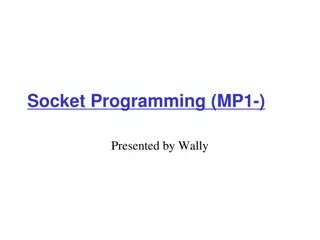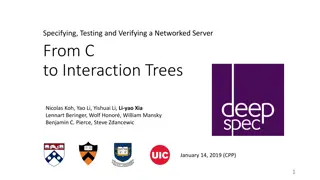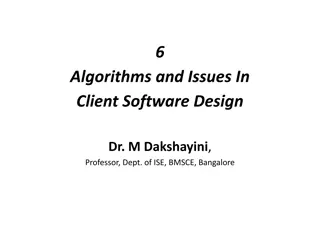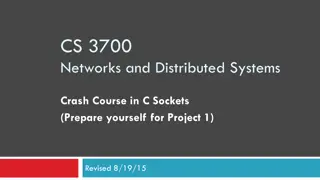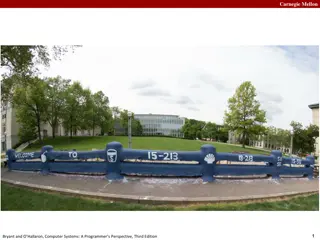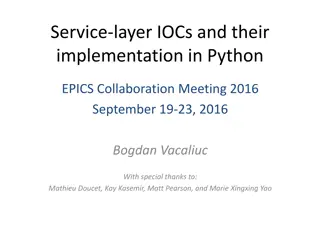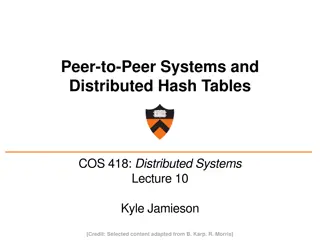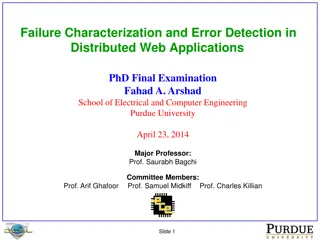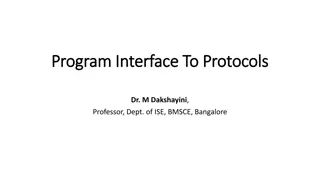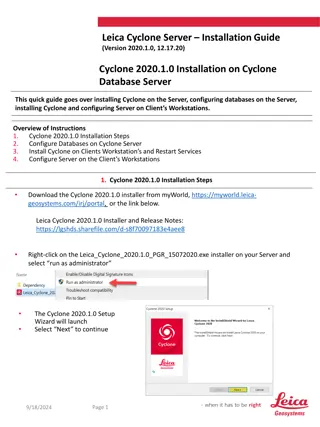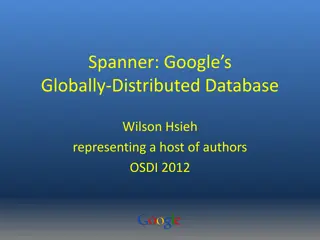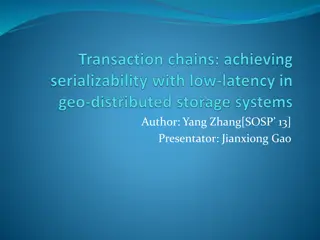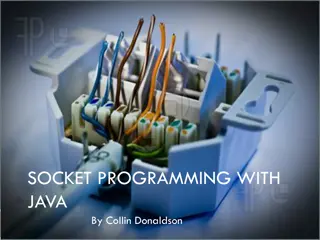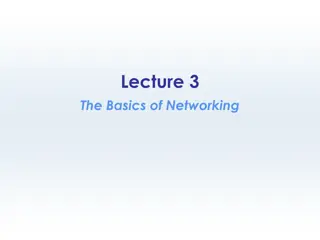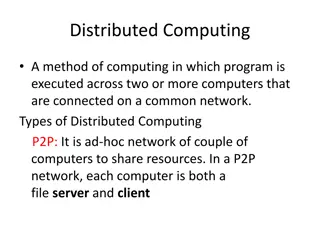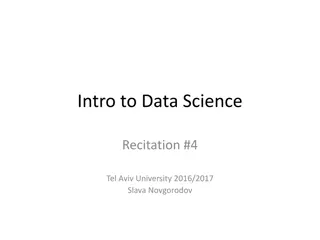Understanding Client-Server Paradigm in Distributed Systems
Client-server paradigm in distributed systems involves structuring systems as collaborating processes where clients request services from servers. The model follows a request/reply protocol, with servers providing centralized control of shared resources. Advantages include security and simplicity, while challenges include robustness and scalability. Different server types cater to various functions in the system. The three-tier client-server model blurs the line between clients and servers, exemplifying the complexity of modern distributed systems.
Download Presentation

Please find below an Image/Link to download the presentation.
The content on the website is provided AS IS for your information and personal use only. It may not be sold, licensed, or shared on other websites without obtaining consent from the author. Download presentation by click this link. If you encounter any issues during the download, it is possible that the publisher has removed the file from their server.
E N D
Presentation Transcript
Distributed Systems Structural Models Papadakis Harris Dept. of Engineering Informatics of Crete
Client/Server Paradigm Basic idea: to structure the system as a set of collaborating processes Servers (or servers) that offer their services E.g. file system service, database service Customers who are consumers of the services A client-server system is a system in which the network connects various resources Thus, clients (or front end) can request services from a server (or back end) that offers information or additional computing power
Client/Server Paradigm The model is usually based on a simple request / reply protocol, The client sends an application request asking the server for a service The server performs the service and returns the requested data or an error message In other words, in the client-server model, the client places an requests and the server returns a response and/or makes a series of actions The server can be activated immediately for this request or add the request to a queue
Client/Server Paradigm Server types can include the following: Application servers Data servers Compute servers Database servers Resource or Communications servers Transaction servers (combine the functions of the database server and application server)
Client/Server Paradigm Advantages The server provides centralized control of shared resources Since the client communicates with the server via a defined interface system, it does not need to know the server or how it works Security Simplicity Disadvantages Robustness Scalability
Three Tier C/S Model The distinction between customers and servers is often unclear For example, a database server may also be a client of a file server in which database tables are stored, acting as intermediaries between base clients and file servers The database server provides processing of primary data to meet customer requests In practice, the three-level customer and server organization is the most common in distributed database management systems (which is a common application) The first level provides the user interface, The second is the processing of data (data processing) The third is the storage of data (data storage)
Three Tier C/S Model The interface tier has a pure client role and contains applications that allows users to interact with the application and the database The complexity of this level may vary considerably In the simplest case, the interface simulates a text terminal, this level being limited to tasks such as editing The most common case is to support a graphical interface with windows, menus and dialog boxes The application handles the screen and the user input devices (mouse and keyboard) and communicates with the next level only to send the user's queries and to display the data returned from the base
Three Tier C/S Model The processing tier provides a bridge between the user interface and the data storage, which can be provided by file servers or database servers The tasks of the processing layer depend on the implemented application, but its purpose is to derive data from general purpose information systems and process them to meet the requirements of the application The utility of distinguishing storage and processing roles lies in the fact that data can be used in different ways For example, search meta-engines provide a new level of processing that converts user questions into queries to multiple search engines, evaluates results, and returns a more complex site to the user
Three Tier C/S Model The storage tier It has a pure server role, since it contains the applications that manage the data that the user finally accesses This level is independent of the processing level, in the sense that the data stored is available even when the processing application is not used So that the same level of storage can be used with many different processing levels, which is very common in practice The storage level can be either a file system or an integrated database
Three Tier C/S Model The storage tier The data tier is generally also responsible for maintaining the consistency of data in relation to different applications The data is organized independently of the applications, in such a way that the changes in this organization do not affect the applications, nor do the applications affect the organization of the data In those cases where the functions in the data are more readily expressed by object manipulations, it is logical for the data layer to be implemented with an object-oriented database Such a database contains the implementation of the functions that can be performed on these objects Therefore, some of the functionalities that are at the processing level are now being moved to the data layer
Three Tier C/S Model The classic client-server model is made up of two logical entities, one for each role, usually located on different machines A customer machine A server machine The simplest architecture is to keep only the client interface level and transfer to the server the processing and storage levels The problem of this way of organizing is that it is not really distributed
Multi-Tier architectures Physically two-tiered architecture When this model expands to three logical levels, the division of levels into machines can be done in various ways One solution is to divide the interface layer between the client and the server so that the terminal control is done to the client but the data presentation and the application control are controlled by the server So the client is completely standardized, regardless of the applications, since they are actually implemented on the server For example, it may be a browser, so applications do not require additional installation, management, and maintenance actions
Multi-Tier architectures Moving in the opposite direction, we can transfer part of the processing to the customer In order to control the input and some processing of the results locally without involving the server For example, the client can check the validity of the input data in date fields We can go further, transferring part and the storage level to the customer For example, a browser will gradually create a local disk base with web pages from the Internet to speed up browsing, basically taking part of the storage layer through the local base
Multi-Tier architectures Physically three-tiered architecture The server can also act as a client Programs that are part of the processing layer are located on a separate server, but there is also the option of being partly distributed among the client and server machines Example: transaction processing A separate process called a transaction controller coordinates all transactions on potentially different data servers
Additional Distribution In a distributed large scale system, apart from the fact that applications can be distributed on the logical levels (interface, processing and storage), the processing and storage levels themselves can be further distributed Vertical distribution The allocation of different logical tasks to different machines, like in three-tier models
Additional Distribution Multiple machines participate in the operation of a single tier For instance, a distributed database serving as the storage tier Horizontal distribution Customers can also be distributed Collaborative applications may not have a single server Then we talk about peer-to-peer distribution Customers perform the same application to start a session Later a third customer can contact either of them, and then also start the same application software
P2P Paradigm Complete decentralization No special purpose components (i.e: servers) Main types of P2P Systems Unstructured Structured
P2P Paradigm Advantages Robustness Scalability Self-organizing Disadvantages Security Scalability
Unstructured P2P Systems Gnutella Random graph Highly-robust Flood-based resource location Inefficient traffic load due to Duplicate messages Topology mismatch
Unstructured P2P Systems Flooding
Improvements Dynamic Querying SuperNodes
Structured P2P Systems Based on Distributed Hash Tables In order to avoid blind search Insert <key,value> pairs Data (value) assigned a key from a uniform hash function Nodes also assigned a key from a uniform hash function Each node stores data whose key is closest to its own More organized topology More efficient lookup Less robust More attack-prone
Structured P2P Systems Chord
Structured P2P Systems Churn The continuous process of node arrival and departure in DHTs. One metric of churn is session time-time between when a node joins the network until the next time it leaves. Also consider lifetime and availability. Even temporary loss of routing neighbor weakens the correctness (consistency) and performance of DHTs. Unavailability of neighbors reduce a node s effective connectivity, forcing it to choose suboptimal routes and increasing the failures.
Structured P2P Systems Kademlia Based on Hamming distance Allows for more versatility and thus robustness
